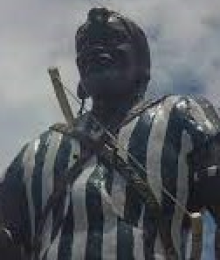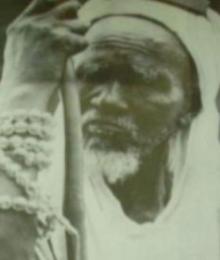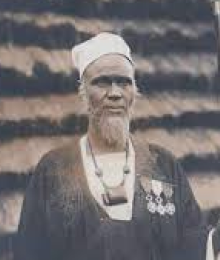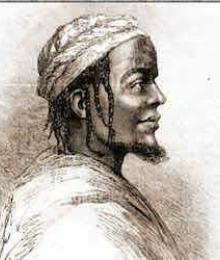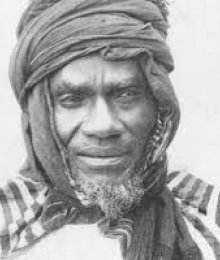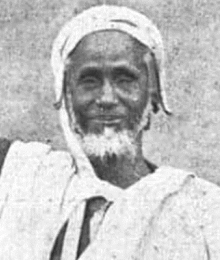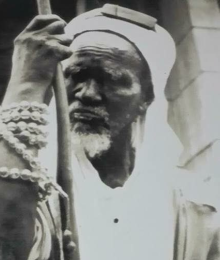
El Hadj Omar Tall (1794-1864) was a war leader, Muslim scholar, and leader of the Tijaniyya Sufi brotherhood from Fouta-Toro in present-day Senegal. Born into a lineage of notable Fulani leaders, he received a solid Islamic education from a young age. After an 18-year pilgrimage across North Africa and the Middle East, during which he was appointed caliph of the Tijaniyya, he established the community of Dinguiraye in Guinea in 1848.
From there, he launched a jihad in 1850 against non-Muslim populations, gradually conquering a vast Toucouleur Empire that stretched from Upper Senegal to present-day Mali. Ruling his territories according to Islamic law, he faced resistance from the Bambara kingdoms and the French colonial army until his mysterious disappearance in 1864 in the caves of Bandiagara.
Introduction
El Hadj Omar Tall, born between 1794 and 1797 in Halwar, in present-day Fouta-Toro, Senegal, was a war leader, Muslim scholar, and leader of the Tijaniyya Sufi order. Regarded as one of the greatest spiritual and military leaders of 19th-century West Africa, he established a vast Toucouleur Empire covering the present-day territories of Guinea, Senegal, Mauritania, and Mali. His epic journey, chronicled in the Kacida written by his companion Mohamadou Allou Tyam, became a foundational myth of the Islamization of this region.
A Childhood Marked by Spirituality
Born into a notable Fulani family of religious leaders, Omar Tall received a strict Islamic education from an early age. His father, Saidou Tall, and his mother, Sokhna Adama Aïssé Thiam, ensured he mastered the teachings of the Quran and the Arabic language. Eager for knowledge, young Omar studied under Muslim scholars, particularly Abd el-Karim, an intellectual from the Tijaniyya brotherhood originating from Fouta-Djalon.
Initiatory Journeys (1827-1845)
At the age of 23, Omar Tall embarked on an 18-year-long pilgrimage that would shape his destiny. His journey began in Hamdallaye on the Niger River, where he met Cheikhou Amadou, founder of the theocratic Macina Empire. Continuing his travels, he visited Sokoto at the court of Mohammed Bello, traversed the Fezzan, and reached Cairo before arriving in Mecca in 1828.
In the holy city, Omar Tall received the titles of "El Hadj" and caliph of the Tidjaniya brotherhood for sub-Saharan Africa from Muhammad Al Ghâlî. He officially joined this Sufi order in 1833 under the mentorship of Mohammed el-Ghali Boutaleb. His years of wandering also took him to Al-Azhar University in Cairo, the court of the Sultan of Bornu, where he married one of the Sultan's daughters, and back to Hamdallaye with Cheikhou Amadou.
The Foundation of Dinguiraye and Preparation for Jihad (1848-1850)
Upon returning to Fouta-Djalon in 1848, El Hadj Omar settled in Dinguiraye, in present-day Guinea, where he established a prosperous religious community. For thirteen years, he preached Sunni Islam following Ash'ari theology, Maliki jurisprudence, and Tijaniyya spirituality, gradually gaining a reputation as a saintly figure. Many disciples gathered around him, forming the core of his future army.
In 1850, El Hadj Omar launched his jihad (holy war) against the non-Muslim populations of the region. His army, equipped with light European firearms obtained from British traders in Sierra Leone, attacked the Serer, Wolof, Soninke, and Khassonke peoples, occupying their territories as well as Bambouk in 1853.
The Conquest of an Empire (1854-1862)
El Hadj Omar's military campaign rapidly expanded. In 1854, he captured the Bambara capital of Nioro, marking the start of the conquest of the Massassi kingdom. Two years later, in 1856, he annexed the Bambara kingdom of Kaarta, harshly suppressing revolts.
Simultaneously, El Hadj Omar faced the French colonial army, led by Louis Faidherbe. After declaring war on the Kingdom of Khasso in 1857 and besieging the fort of Médine, his forces were repelled by Faidherbe in July of that year.
Between 1858 and 1861, the Toucouleur leader focused on the Bambara kingdoms of Kaarta and Ségou. On March 10, 1861, he captured the capital of Ségou, which he handed over to his son Ahmadou a year later. His campaign culminated in the capture of Hamdallaye, the capital of the Fulani Empire of Macina, on March 16, 1862, after three bloody battles that claimed over 70,000 lives.
A Theocratic and Slave-Holding State
El Hadj Omar ruled his vast territories as a theocratic state, applying Islamic law as the fundamental principle. Assisted by a council of great marabouts, his brothers, and traveling companions, he modeled his governance on the Egyptian-Turkish system, dividing power between a civil governor and a military governor.
Despite his universalist Islamic ideology and vision of an egalitarian societal renewal, El Hadj Omar's empire heavily relied on the slave trade, much like the Fulani colonization led by Modibbo Adama in Adamawa.
The Mysterious End of a Conqueror (1864)
In 1864, after capturing Hamdallaye, El Hadj Omar faced a revolt that forced him to take refuge in the caves of Deguembéré near Bandiagara. It was there, under obscure circumstances, that the great conqueror mysteriously disappeared on February 12, 1864.
His nephew, Tidiani Tall, succeeded him as the leader of the empire, establishing the capital in Bandiagara. His son, Ahmadou Tall, ruled over Ségou, Nioro, and parts of the Niger until the French conquest in 1893. Another son, Aguibou Tall, was appointed Sultan of Macina by the French in 1892.
Conclusion
The epic of El Hadj Omar Tall, as recounted in the Kacida of Mohamadou Allou Tyam, profoundly shaped the collective memory of West African peoples. Although his empire lasted only a few decades, his spiritual quest, military conquests, and vision of an Islamic state left a lasting mark on the region's history. El Hadj Omar remains a significant figure in the spread of Islam and the resistance against European colonization in the 19th century.












